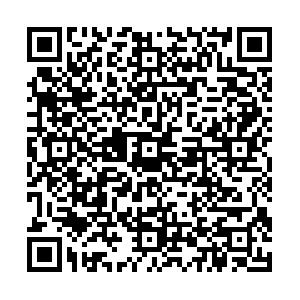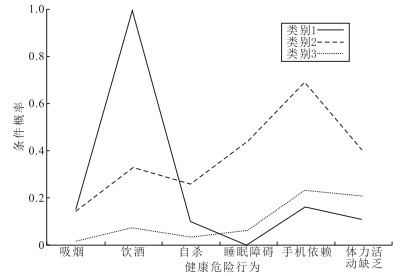Latent classes of health risk behaviors in medical students and depressive symptoms
-
摘要:
目的 识别医学生多种健康危害行为的潜在类别,并进一步分析不同潜类别与抑郁症状的关联。 方法 采用方便抽样的原则,于2018年10月在安徽医科大学整群抽取2 014名医学生开展横断面调查。使用自编手机问卷,调查内容包括一般人口学资料、健康危害行为评价以及抑郁症状。采用潜在类别分析方法分析吸烟、饮酒、自杀、睡眠障碍、手机依赖、缺乏运动等6种健康危害行为潜在类别,采用Logistic回归方法进一步分析不同类别与抑郁症状的关联。 结果 医学生健康危害行为分为物质依赖组(8.4%)、手机依赖组(22.4%)和低危风险组(69.2%)3个潜在类别。不同性别、专业、年级、是否为独生子女、父亲文化程度、每月生活费、学习成绩及朋友个数之间医学生健康危害行为分布差异均有统计学意义(χ2值分别为99.37,19.07,12.05,6.64,14.28,19.35,20.61,26.39,P值均 < 0.05)。Logistic回归分析结果显示,调整性别、专业、年级、独生子女及父亲文化程度、每月生活费、学习成绩以及朋友个数后,手机依赖组与抑郁症状呈正相关(β=1.75,P < 0.01)。 结论 医学生健康危害行为呈现类别分布,各潜类别健康危害行为与抑郁症状关联不同。提示学校卫生工作者在今后的教育活动中应针对医学生不同类别的健康危害行为制定个体化干预方案,进行分层干预,缓解抑郁症状,促进学生心理健康。 Abstract:Objective To identify the latent classes of various health risk behaviors among medical students and further analyze the correlation between different classes and depression. Methods Using the method of convenient sampling, 2 014 medical students were selected from Anhui Medical University in October 2018. Self-designed online questionnaire were used to collect demographic data, health risk behavior (including smoking, drinking, suicide, sleep disorders, mobile phone dependence and lack of exercise) and depressive symptoms. Latent Class Analysis was used to cluster individuals. Logistic regression was provided to further analyze the association between health risk behaviors and depressive symptoms for the groups. Results The health hazard behaviors of medical students could be divided into three separate classes: substance dependence group (8.4%), mobile phone dependence group (22.4%) and low-risk group (69.2%). The distribution of health risk behaviors of medical students with different gender, major, grade, only child, father's educational level, monthly living expenses, academic achievement and number of friends were statistically significant (χ2=99.37, 19.07, 12.05, 6.64, 14.28, 19.35, 20.61, 26.39, P < 0.05). The results of Logistic regression analysis showed that after adjusting for gender, major, grade, only child, father's educational level, monthly living expenses, academic achievement and number of friends, the mobile phone dependence group was positively correlated with depressive symptoms (β=1.75, P < 0.01). Conclusion Different ratent classes of health risk behaviors have different correlation with depressive symptoms in groups.It is suggested that school health workers should make individualized intervention plan for different types of health hazard behavior of medical students in the future educational activities, carry out stratified intervention, alleviate the symptoms of depression and promote the mental health of medical students. -
Key words:
- Mental health /
- Dangerous behavior /
- Depression /
- Regression analysis /
- Students
-
表 1 医学生健康危害行为的潜在类别模型适配指标(n=2 014)
Table 1. Criteria for deciding the number of classes of health risk behaviours among medical students (n=2 014)
类别数目 参数条目 LogL AIC BIC aBIC Entropy LMR BLRT 类别概率 1 6 -5 179.88 10 371.76 10 405.41 10 386.35 2 13 -5 059.35 10 144.70 10 217.60 10 176.30 0.51 0.00 0.00 0.19/0.81 3 20 -5 037.72 10 115.44 10 227.60 10 164.06 0.65 0.00 0.00 0.08/0.69/0.22 4 27 -5 020.52 10 095.04 10 246.45 10 160.67 0.64 0.03 0.00 0.04/0.17/0.32/0.47 5 34 -5 010.67 10 089.34 10 280.01 10 171.99 0.66 0.48 0.00 0.06/0.33/0.03/0.01/0.57 表 2 不同社会人口学特征医学生健康危害行为的潜在类别分布比较
Table 2. Sociodemographic characteristics of the three classes of health risk behaviours in medical students, in percentages
社会人口学指标 人数 物质依赖组 手机依赖组 低危风险组 χ2值 P值 性别 男 791 130(16.43) 179(22.63) 482(60.94) 99.37 < 0.01 女 1 223 65(5.31) 185(15.13) 973(79.56) 专业 护理 754 53(7.03) 115(15.25) 586(77.72) 19.07 < 0.01 临床 1 260 142(11.27) 249(19.76) 869(68.97) 年级 大一 738 73(9.89) 125(16.94) 540(73.17) 12.05 0.02 大二 699 82(11.73) 139(19.89) 478(68.38) 大三 577 40(6.93) 100(17.33) 437(75.74) 独生子女 是 724 82(11.33) 143(19.75) 499(68.92) 6.64 0.04 否 1 290 113(8.76) 221(17.13) 956(74.11) 出生地 农村 1 567 146(9.32) 285(18.19) 1 136(72.50) 1.08 0.58 城市 447 49(10.96) 79(17.67) 319(71.36) 父亲文化程度 小学及以下 423 35(8.27) 95(22.46) 293(69.27) 14.28 0.01 初中 805 69(8.57) 126(15.65) 610(75.78) 高中及以上 786 91(11.58) 143(18.19) 552(70.23) 母亲文化程度 小学及以下 837 79(9.44) 158(18.88) 600(71.68) 6.04 0.20 初中 635 57(8.98) 99(15.59) 479(75.43) 高中及以上 542 59(10.89) 107(19.74) 376(69.37) 每月生活费/元 < 1 000 588 39(6.63) 100(17.01) 449(76.36) 19.35 0.00 1 000~1 500 1 163 121(10.40) 202(17.37) 840(72.23) >1 500 263 35(13.31) 62(23.57) 166(63.12) 学习成绩 较差 516 54(10.41) 124(24.03) 338(65.50) 20.61 < 0.01 中等 1 103 99(8.98) 185(16.77) 819(74.25) 较好 395 42(10.63) 55(13.92) 298(75.44) 朋友个数/个 <3 504 29(5.75) 116(23.02) 359(71.23) 26.39 < 0.01 3~5 507 42(8.28) 84(16.57) 381(75.15) >5 1 003 124(12.36) 164(16.35) 715(71.29) 注: ()内数字为构成比/%。 表 3 医学生健康危害行为潜类别分组与抑郁症状关联性的Logistic回归分析(n=2 014)
Table 3. Association between classes of health risk behaviours and prevalence of depressive symptom in medical students, in unweighted numbers and weighted adjusted odds ratios with 95% confidence intervals (n=2 014)
潜在类别 模型1 模型2 β值 标准误 Wald χ2值 OR值(OR值95%CI) P值 β值 标准误 Wald χ2值 OR值(OR值95%CI) P值 类别3 1.00 1.00 类别1 0.14 0.18 0.61 1.15(0.81~1.63) 0.43 -0.05 0.19 0.08 0.95(0.66~1.37) 0.78 类别2 -1.78 0.13 195.47 0.17(0.13~0.22) < 0.01 1.75 0.13 175.04 5.75(4.43~7.44) < 0.01 注:模型1为原始模型;模型2为控制性别、专业、年级、独生子女、父亲文化程度、每月生活费、学习成绩以及朋友个数。 -
[1] 季成叶. 青少年健康危险行为[J]. 中国学校卫生, 2007, 28(2): 289-291. http://www.cjsh.org.cn/article/id/zgxxws201301007JI C Y. Adolescent health risk behavior[J]. Chin J Sch Health, 2007, 28(2): 289-291. http://www.cjsh.org.cn/article/id/zgxxws201301007 [2] 陶芳标. 青少年健康危害行为的研究[J]. 中国学校卫生, 2007, 28(7): 579-583. doi: 10.3969/j.issn.1000-9817.2007.07.002TAO F B. The study of Adolescent health risk behavior[J]. Chin J Sch Health, 2007, 28(7): 579-583. doi: 10.3969/j.issn.1000-9817.2007.07.002 [3] JESSOR R. Risk behavior in adolescence: a psychosocial framework for understanding and action[J]. J Adolesc Health, 1991, 12(8): 597-605. doi: 10.1016/1054-139X(91)90007-K [4] 刘志浩, 廉启国, 卫平民, 等. 南京市大学生健康危险行为聚集模式分析[J]. 中国学校卫生, 2013, 34(10): 1193-1194, 1197. http://www.cjsh.org.cn/article/id/zgxxws201310015LIU Z H, LIAN Q G, WEI P M, et al. Cluster analysis of health risk behaviors among college students in Nanjing[J]. Chin J Sch Health, 2013, 34(10): 1193-1194, 1197. http://www.cjsh.org.cn/article/id/zgxxws201310015 [5] 郭帅军, 余小鸣, 张芯, 等. 大学生吸烟、饮酒等健康危险行为的聚集现象分析[J]. 北京大学学报(医学版), 2013, 45(3): 382-386. doi: 10.3969/j.issn.1671-167X.2013.03.009GUO S J, YU X M, ZHANG X, et al. Cluster analysis of smoking, alcohol drinking and other health risk behaviors in undergraduate students[J]. J Peking Univ(Health Sci), 2013, 45(3): 382-386. doi: 10.3969/j.issn.1671-167X.2013.03.009 [6] 张莉, 李晶华, 王竞, 等. 大学生健康危险行为的聚类分析[J]. 中国高等医学教育, 2018, 259(7): 37-38. doi: 10.3969/j.issn.1002-1701.2018.07.019ZHANG L, LI J H, WANG J, et al. Cluster analysis on health risk behavior of college students[J]. Higher Med Educ Chin, 2018, 259(7): 37-38. doi: 10.3969/j.issn.1002-1701.2018.07.019 [7] MOK J Y, CHOI S W, KIM D J, et al. Latent class analysis on internet and smartphone addiction in college students[J]. Neuropsych Dis Treat, 2014, 10: 817-828. DOI: 10.2147/NDT.S59293. [8] 吉园依, 徐寰宇, 张宇, 等. 四川省农村留守儿童健康危险行为潜类别分析[J]. 中国公共卫生, 2017, 33(9): 1297-1301. https://www.cnki.com.cn/Article/CJFDTOTAL-ZGGW201709002.htmJI Y Y, XU H Y, ZHANG Y, et al. Health risk behaviors among rural left behind children in Sichuan province[J]. Chin J Public Health, 2017, 33(9): 1297-1301. https://www.cnki.com.cn/Article/CJFDTOTAL-ZGGW201709002.htm [9] 周海茸, 洪忻, 王志勇, 等. 南京中学生健康危险行为与抑郁症状关系[J]. 中国公共卫生, 2015, 31(1): 49-52. https://www.cnki.com.cn/Article/CJFDTOTAL-ZGGW201501017.htmZHOU H R, HONG X, WANG Z Y, et al. Relationship between health risk behaviors and depression symptoms among high school students in Nanjing[J]. Chin J Public Health, 2015, 31(1): 49-52. https://www.cnki.com.cn/Article/CJFDTOTAL-ZGGW201501017.htm [10] EATON D K, KANN L, KINCHEN S, et al. Youth risk behavior surveillance United States, 2011[J]. MMWR Surveill Summar, 2012, 61(4): 1-162. http://search.ebscohost.com/login.aspx?direct=true&db=aph&AN=82713873&site=ehost-live [11] 陶舒曼, 付继玲, 王惠, 等. 青少年手机使用依赖自评问卷编制及其在大学生中的应用[J]. 中国学校卫生, 2013, 34(1): 26-29. http://www.cjsh.org.cn/article/id/zgxxws201301009TAO S M, FU J L, WANG H, et al. Development of self-rating questionnaire for adolescent problematic mobile phone Use and the psychometric evaluation in undergraduates[J]. Chin J Sch Health, 2013, 34(1): 26-29. http://www.cjsh.org.cn/article/id/zgxxws201301009 [12] BUYSSE D J, REYNOLDS C F, MONK T H, et al. The Pittsburgh Sleep Quality index: a new instrument for psychiatric practice and research[J]. Psychiat Res, 1989, 28(2): 193-213. doi: 10.1016/0165-1781(89)90047-4 [13] 屈宁宁, 李可基. 国际体力活动问卷中文版的信度和效度研究[J]. 中华流行病学杂志, 2004, 25(3): 265-268. doi: 10.3760/j.issn:0254-6450.2004.03.019QU N N, LI K J. Study on the on the reliability and validity of International physical activity questionnaire(Chinese vision, IPAQ)[J]. Chin J Epidemiol, 2004, 25(3): 256-258. doi: 10.3760/j.issn:0254-6450.2004.03.019 [14] RADLOFF L S. The use of the center for epidemiologic studies depression Scale in adolescents and young adults[J]. J Youth Adolescent, 1991, 20(2): 149-166. doi: 10.1007/BF01537606 [15] COLLINS L M, LANZA S T. Latent class and latent transition analysis: with applications in the social, behavioral, and health sciences[M]. New York, NY: Wiley, 2013. [16] MUTHÉN L K, MUTHÉN C. Mplus: Statistical Analysis with Latent Variables (Version 4.21) Computer software[C]. International Conference on Transparent Optical Networks, 2007. [17] TAO S, WU X, ZHANG Y, et al. Effects of sleep quality on the association between problematic mobile phone use and mental health symptoms in chinese college students[J]. Intern J Environ Res Public Health, 2017, 14(2): 185. doi: 10.3390/ijerph14020185 [18] PARK S Y, YANG S, SHIN C S, et al. Long-term symptoms of mobile phone use on mobile phone addiction and depression among Korean adolescents[J]. Int J Environ Res Public Health, 2019, 16(19): 3584-3594. doi: 10.3390/ijerph16193584 -







 下载:
下载:

